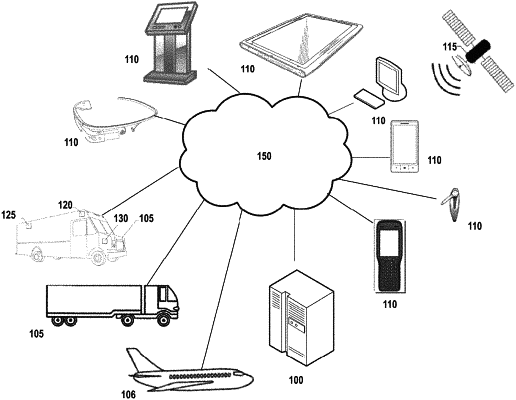| CPC G06Q 10/0833 (2013.01) [G06Q 10/0838 (2013.01)] | 20 Claims |

|
1. A self-configuring shipment monitoring system for monitoring a plurality of shipments, the system comprising one or more memory storage areas and at least one processor, the system configured to:
receive customer data comprising customer-defined shipping requirements for a plurality of customers;
at least partially in response to the receiving of the customer-defined shipping requirements, automatically decode, by one or more electronic control module (ECM) devices, real-time tracking data received from one or more location sensors and received from one or more telematics sensors attached to each vehicle, of a plurality of vehicles that carry the plurality of shipments for the plurality of customers, wherein the one or more telematics sensors are not attached to the shipments, and wherein the real-time tracking data received from the one or more location sensors indicate a geolocation of a respective vehicle, of the plurality of vehicles, and wherein the real-time tracking data received from the one or more telematics sensors indicate real-time attributes of a respective vehicle, of the plurality of vehicles, the real-time attributes correspond to one or more operational characteristics of the respective vehicle;
present the decoded real-time tracking data to one or more communication buses to transfer the decoded real-time tracking data to one or more data collection devices;
transmit, by the one or more data collection devices, the decoded real-time tracking data to a carrier server;
at least partially in response to the transmitting of the decoded real-time tracking data to the carrier server and based at least in part on analyzing the decoded real-time tracking data, identify, by the carrier server, the plurality of customers and determine geo-coordinates of the plurality of vehicles;
cause generation, by the carrier server and in response to the analyzing of the decoded real-time tracking data for the plurality of shipments, of an interactive user interface that includes a plurality of vehicle indicators that each represent a respective vehicle and geo-coordinates of the respective vehicle of the plurality of vehicles;
based at least in part on the analyzing of the decoded real-time tracking data and further based on one or more milestones not being reached for a first shipment of the plurality of shipments, determine, by the carrier server, that the first shipment is at risk of failing to comply with a customer-defined shipping requirement of a customer of the customer-defined shipping requirements for the plurality of customers; and
based on the determining that the first shipment is at risk of failing to comply with the customer-defined shipping requirement, cause modification of a first vehicle indicator to indicate, at the user interface, that the first shipment is at risk of failing to comply with the customer-defined shipping requirement while not modifying, at the user interface, other of the plurality of vehicle indicators.
|